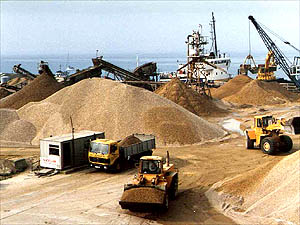Ocean resources
This short article is about ocean resources other than food.
The oceans are a source of natural raw materials such as medicines, feed for livestock, polysaccharides and building materials. The potential for acquiring future raw materials from the marine environment is enormous.
Natural medicines continue to be discovered through the wealth of diversity on the planet. The oceans host a high biochemical diversify resulting from the high phyletic diversity in marine ecosystems, suggesting there may be further potential to extract chemicals for pharmaceuticals from these organisms. Many sessile animals in the ocean defend themselves through chemical means. An example includes the extract (arabinosides), collected from the sponge Tethya crypta and providing the basis for anti-viral drugs and anti-cancer drugs. For further details, see articles in the category Marine Biotechnology.
Red, brown and green algae provide a source of polysaccharides for a variety of human uses. Seaweeds are important in agriculture as feed for livestock and as compost for farmland. Chiton from shrimp and crab shells is used in agriculture as well as in human food supplements. An additional benefit of using these resources is that less of the animal is wasted from the fishery alone.
Aggregates extracted from the marine environment are used for building materials. Sand, gravel and crushed rock are used in the construction industry for housing and road building. Their removal has a physical impact on the seabed and habitat type through removal of material and resettlement of fine particles. Extraction must be carried out in a sustainable manner, as a healthy habitat is a prerequisite for the provision of goods and services from the marine environment.The deep ocean seafloor hosts a large quantity of minerals. Ferromanganese crusts, manganese nodules, phosphorites, and hydrothermal vent deposits, which occur from the Arctic to the Antarctic, are enriched in many metals of great economic value. In areas beyond national jurisdiction, any marine mining is governed by the International Seabed Authority. Studies are ongoing for the development of environmental standards that will be applied for the issuance of commercial mining permits.
